Rhododendron Garden Ideas: Creating a Stunning Floral Oasis
Creating a beautiful garden filled with rhododendrons can transform your outdoor space into a colorful and serene retreat. These vibrant flowering bushes come in a wide range of colors and sizes, making them versatile additions to any garden. How can you design your garden to incorporate these stunning plants and achieve a harmonious look?
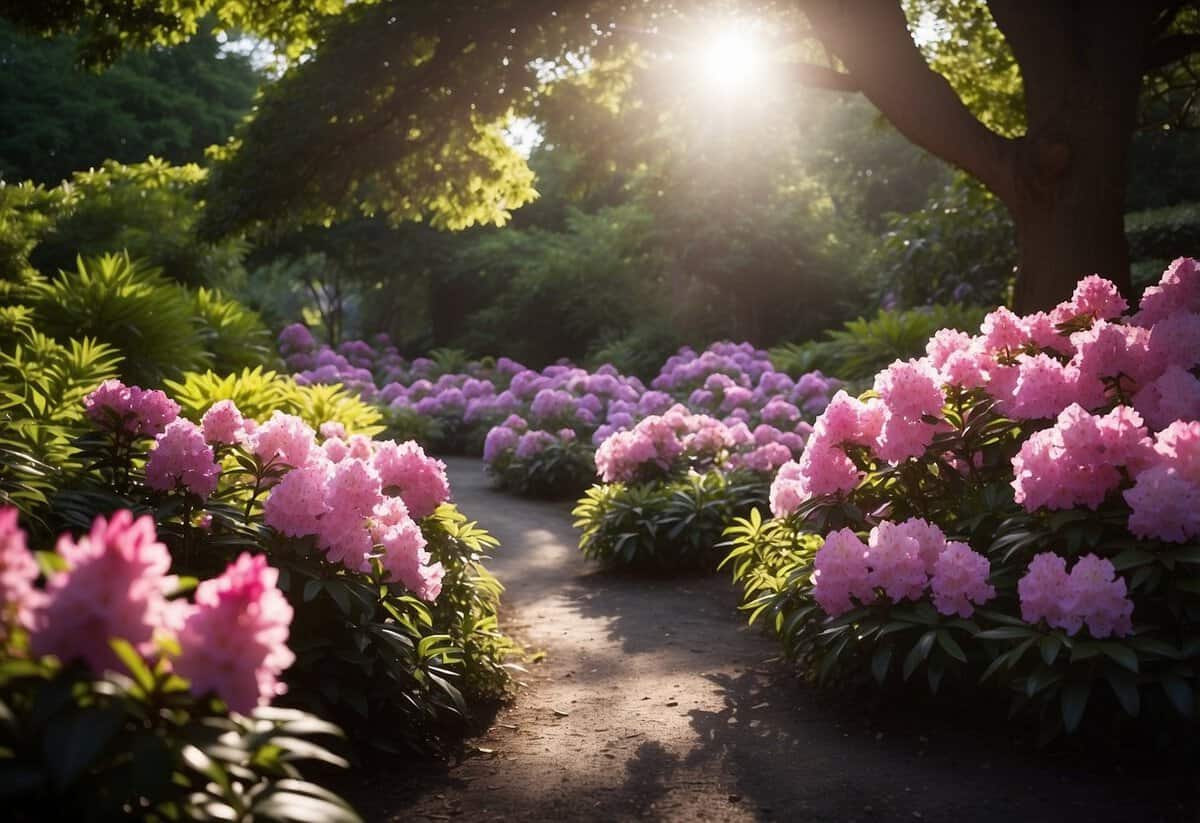
Whether you’re starting from scratch or looking to enhance your existing garden, rhododendrons offer endless possibilities. By understanding their growth habits and care needs, you can make informed choices that will ensure your rhododendrons thrive and flourish.
1) Add a Stone Pathway

Consider adding a stone pathway to your rhododendron garden. This can create a charming and inviting look.
You can use flagstones to make a natural, winding path. Small pebbles can fill in the gaps for added texture.
Choosing stones in various shapes and sizes adds interest. Placing them among the vibrant rhododendron blooms makes your garden look more enchanting.
2) Incorporate Water Features
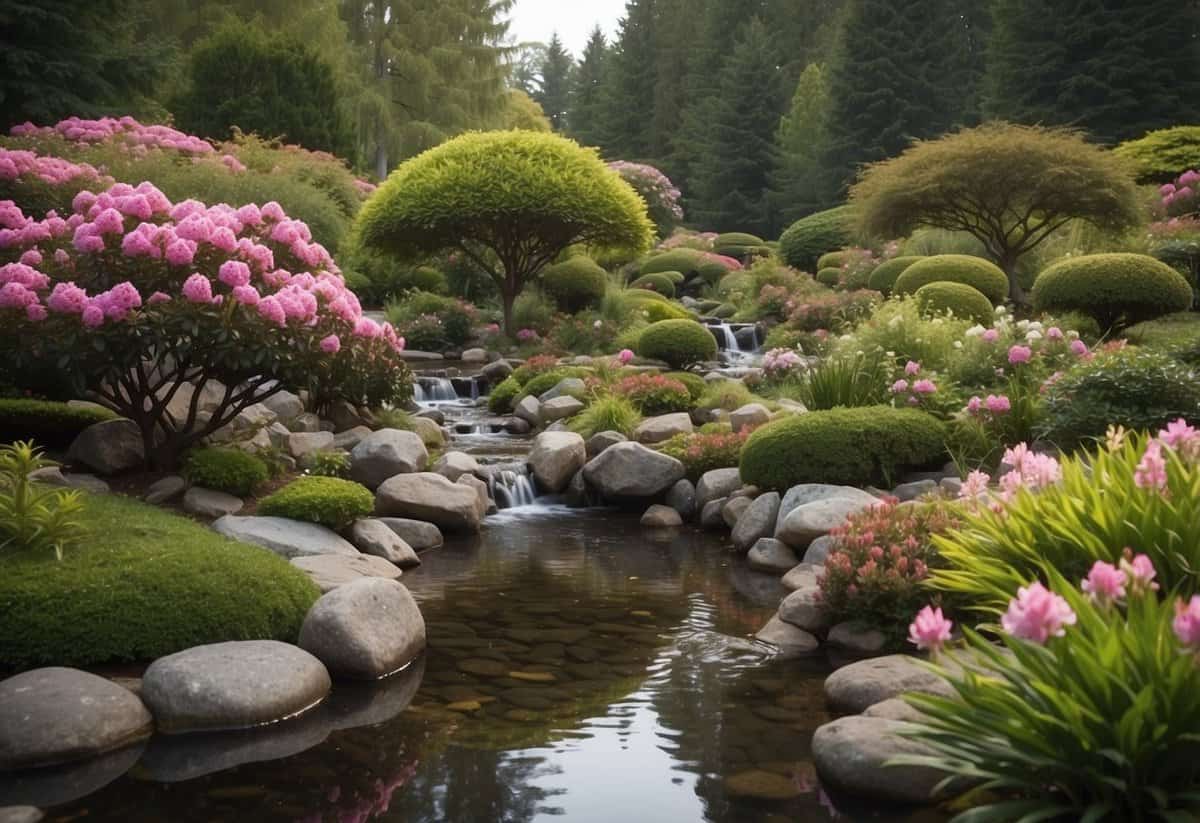
Adding water features to your rhododendron garden can create a peaceful and inviting atmosphere.
You might consider a modern garden pool. A narrow pool of water fits well with the lush greenery of rhododendrons.
Another idea is to install a raised pond. It can serve as a striking focal point in your garden, drawing attention to the beautiful rhododendron blooms.
3) Create a Rhododendron Hedge
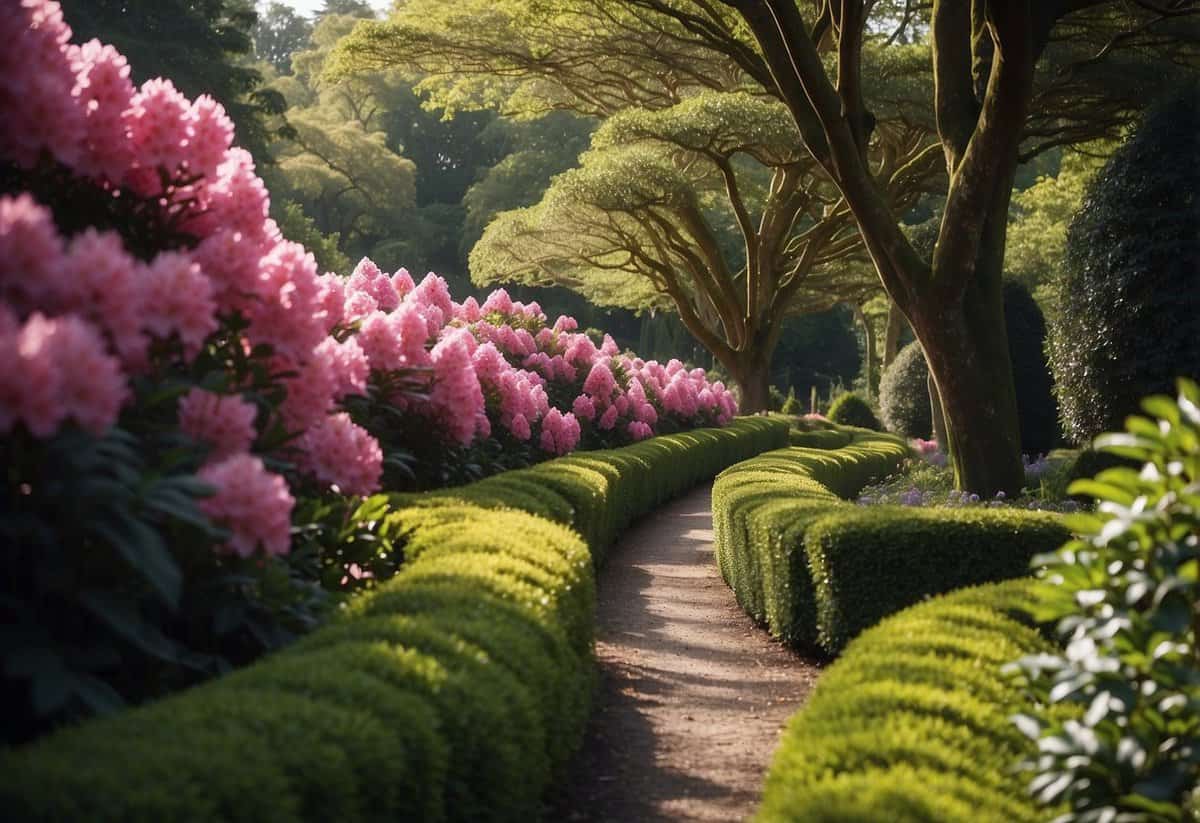
A rhododendron hedge can add vibrant color and year-round greenery to your garden. These shrubs thrive in well-draining, acidic soil with a pH between 4.5 and 6.0.
Plant your rhododendrons in a spot that gets partial shade to full sun. Ensure consistent watering during the first growing season.
Trim regularly to maintain the desired shape and encourage healthy growth. With their beautiful blooms, rhododendron hedges can become a stunning focal point in your garden. For more detailed planting tips, visit Monrovia’s guide.
4) Plant in Colorful Clusters

Planting rhododendrons in colorful clusters can create eye-catching displays in your garden. Group them based on bloom colors for a vibrant look.
Combine varieties like the ‘September Song,’ which produces orange, pink, and yellow blooms, with others for a stunning effect.
Select different types for a range of colors throughout the spring and summer. ‘Nestucca’ Rhododendron can bring in a showy white display. Mixing these can brighten up any space.
5) Mix with Evergreen Shrubs
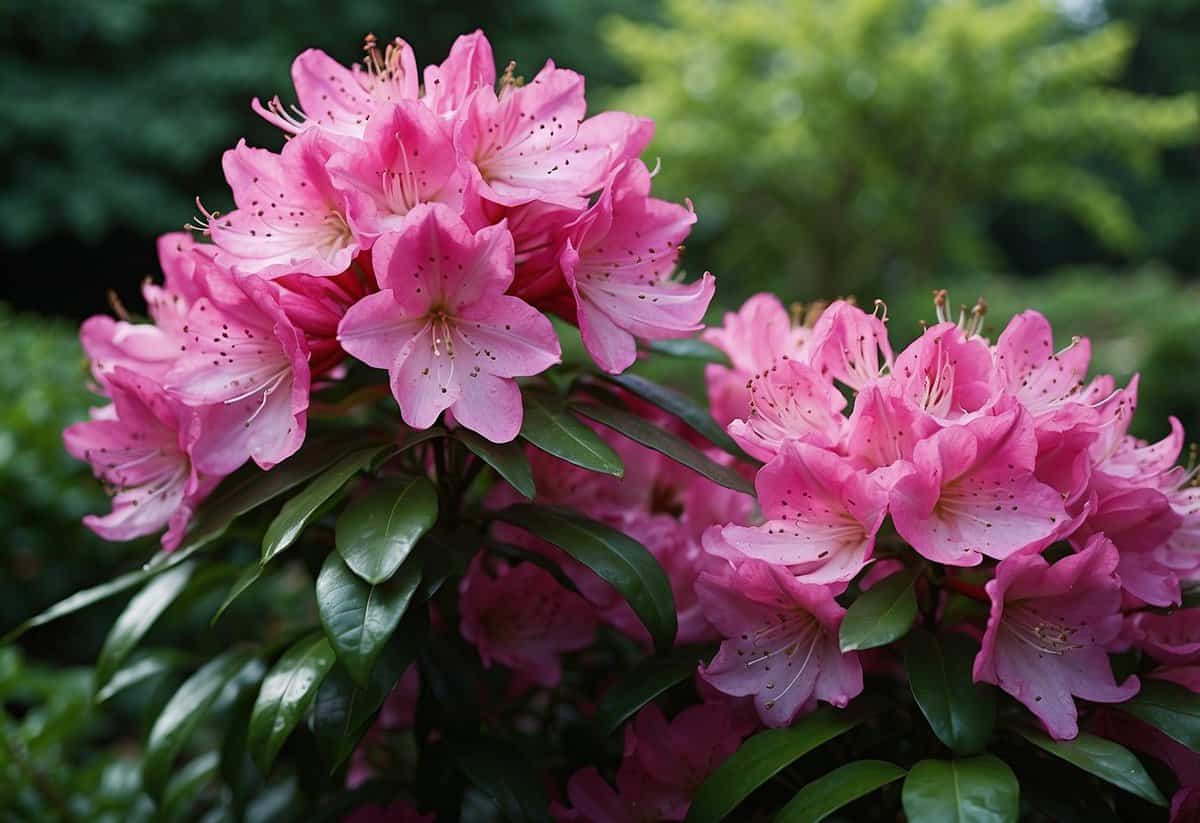
Mixing rhododendrons with evergreen shrubs can create a year-round green backdrop for your garden. Evergreens like Kalmia latifolia (Mountain Laurel) and Pieris japonica (Japanese Andromeda) are great options. They not only look good but also match well with rhododendrons in terms of soil and light needs.
Adding these evergreens helps ensure your garden remains lively and interesting even when your rhododendrons are not in bloom. They provide structure and texture, making your garden more dynamic and beautiful. The evergreen foliage pairs perfectly with the colorful blooms of rhododendrons.
6) Use as a Privacy Screen
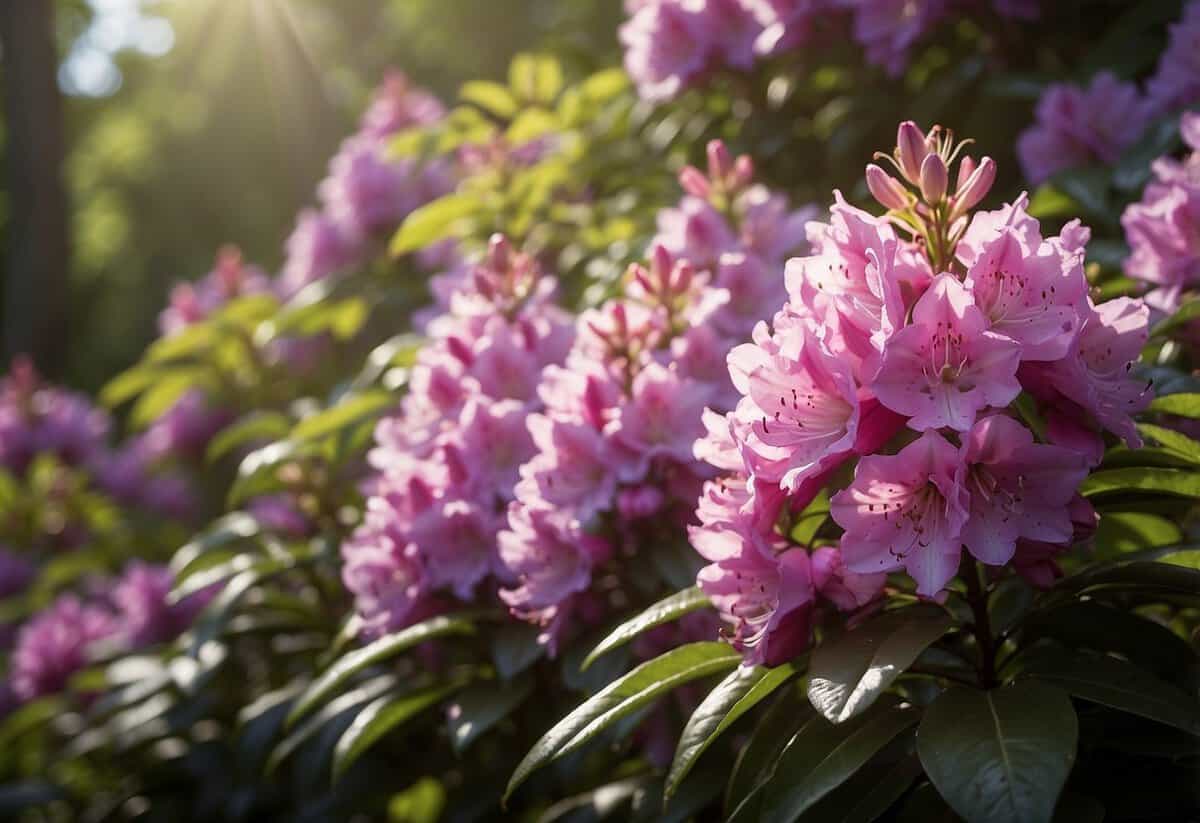
Rhododendrons are excellent choices for creating a natural privacy screen. These plants grow dense and tall, providing a green barrier that can block out unwanted views.
You can plant rhododendrons along the boundary of your yard. Their large leaves and vibrant blooms will beautify the space while giving you the privacy you need.
Consider using varieties like Rhododendron maximum, which can grow up to 15 feet tall, making them perfect for hiding areas from onlookers.
7) Pair with Azaleas
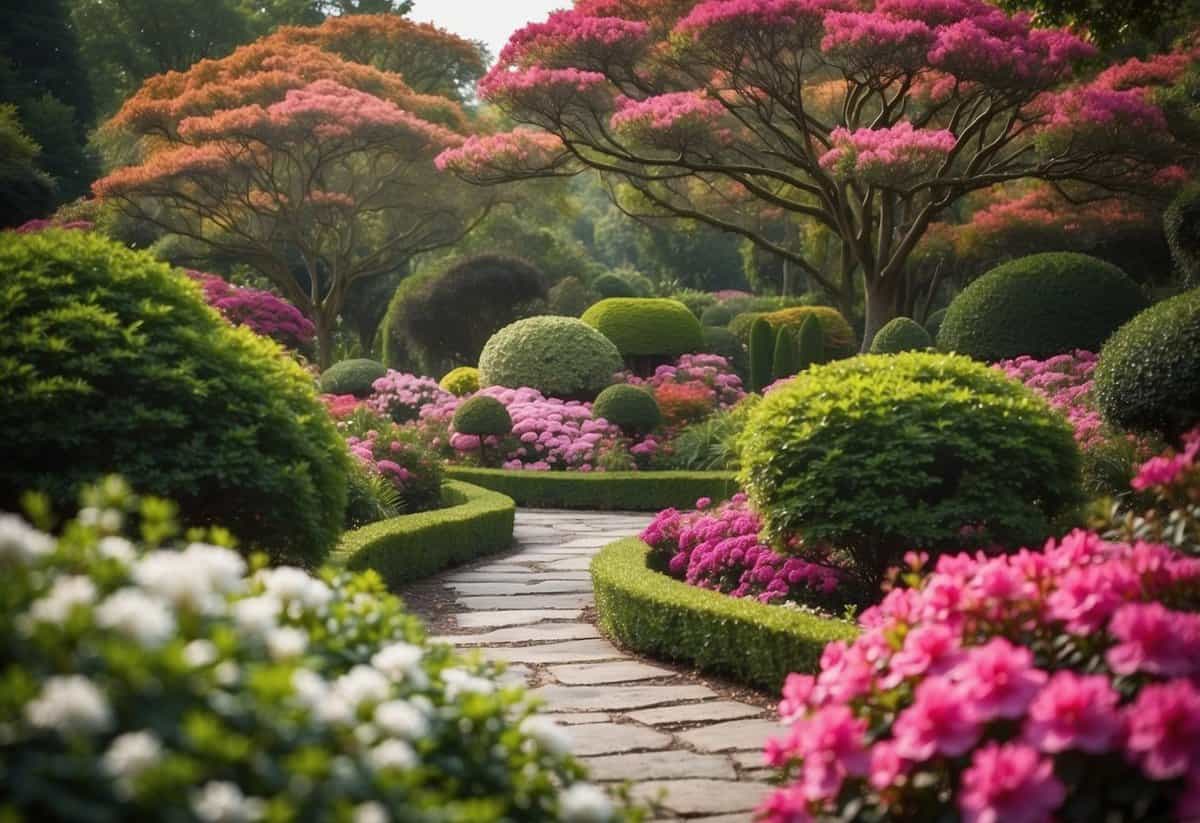
Pairing rhododendrons with azaleas can make your garden look stunning. These two plants have similar soil and light needs, meaning they thrive together. Azaleas prefer acidic soils and dappled sunlight, just like rhododendrons.
When the azaleas bloom with their colorful flowers, they complement the larger, showier rhododendron blooms. This creates a vivid display. Using azaleas as companions adds layers of color and texture to your garden, making it more appealing.
8) Design a Shaded Sitting Area
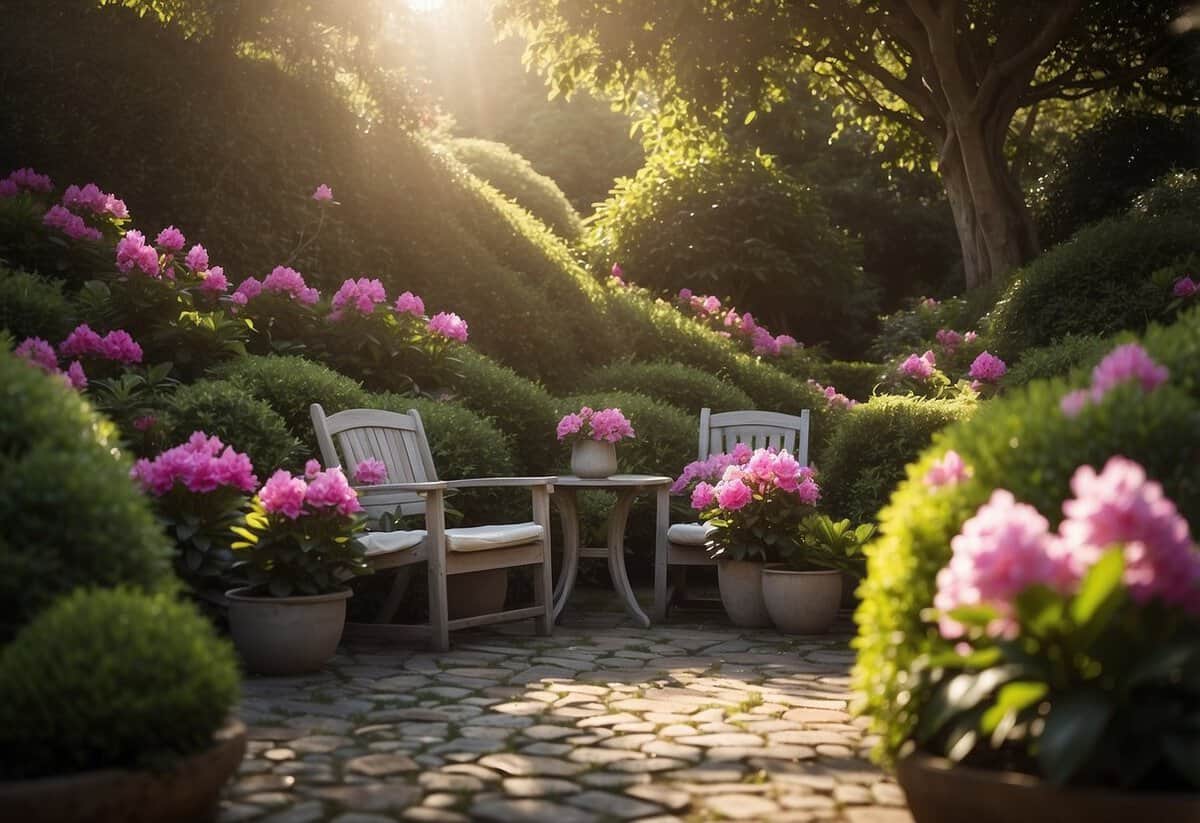
Create a cozy spot under a canopy of trees or next to taller plants like rhododendrons. A simple bench or chairs can make your garden a relaxing retreat.
Use plants like Japanese snowbell or sprinter boxwood to add more shade and beauty. This way, you have a cool place to sit and enjoy your garden.
9) Combine with Ferns

Ferns make excellent companions to rhododendrons. Their shade-loving nature pairs nicely with the dappled sunlight that rhododendrons thrive in.
Adding ferns can give your garden a lush, layered look. They don’t compete for moisture, making them a perfect match. Ferns also act as a natural ground cover, keeping the soil cool and moist.
For some great fern options, consider varieties like Japanese Painted Fern or Maidenhair Fern for visual interest.
10) Add Seasonal Bulbs

Incorporate seasonal bulbs into your rhododendron garden to extend the blooming period. Bulbs like tulips and daffodils bloom early in the spring, adding vibrant colors.
Plant summer bulbs like lilies and gladiolus to keep your garden bright through the warmer months. These pair well with rhododendrons, ensuring a colorful display.
For added charm, consider all season bulb gardens. Plant bulbs that bloom in different seasons to enjoy flowers year-round in your rhododendron garden.
Choosing the Right Rhododendrons

When picking rhododendrons for your garden, it’s crucial to consider your local climate and soil conditions. These factors greatly affect the plant’s health and blooming potential.
Climate Considerations
Rhododendrons thrive in specific climates. Most varieties prefer cooler temperatures and do well in USDA zones 5-8. If you live in a cooler area, you might have more options. For example, some types can tolerate full sun if the summers are mild.
In hot climates, choose rhododendrons that can withstand higher temperatures. It’s essential to plant them where they get morning sun but afternoon shade. This helps to protect them from the harsh afternoon heat.
Always check the plant hardiness zone on the rhododendron varieties you select. This ensures they’re suitable for your region and improves their chances of flourishing in your garden.
Soil and pH Levels
Rhododendrons need well-draining, acidic soil. Aim for a soil pH between 4.5 and 6.0. You can test your soil’s pH with a home test kit or seek advice from a local garden center.
To improve soil drainage, add organic matter like compost or pine bark. This not only helps with drainage but also enhances soil texture and fertility.
If planting in containers, choose pots that are at least 12 inches deep and 16 inches wide. This provides enough space for the roots to grow. Regularly check and maintain the soil’s acidity and drainage conditions to keep your rhododendrons healthy.
Designing Your Rhododendron Garden

When designing your rhododendron garden, it’s essential to consider layout, spacing, and color combinations. Proper planning will create a striking and harmonious landscape.
Layout and Spacing
Begin by sketching a rough layout of your garden. Rhododendrons need enough space to grow without feeling cramped. Typically, these shrubs can reach 4 to 5 feet tall and wide.
Consider these tips:
- Tall Varieties: Place larger varieties at the back or center. This ensures they don’t block shorter plants.
- Small Varieties: Use dwarf varieties like ‘Yaku Prince’ which grow 2 to 4 feet tall, in the front.
- Grouping: Grouping rhododendrons together can create focal points. However, space them adequately to prevent overcrowding.
Spacing Guidelines:
- Small Varieties: 3-4 feet apart
- Medium Varieties: 4-6 feet apart
- Large Varieties: 6-10 feet apart
Proper spacing not only ensures better air circulation but also allows each plant to reach its full potential.
Color Combinations
Choosing the right colors will make your garden vibrant and visually appealing. Rhododendrons come in various hues such as pink, red, white, and yellow.
Matching Colors:
- Warm Tones: Combine yellows, oranges, and reds for a fiery look.
- Cool Tones: Mix pinks, purples, and blues for a calming effect.
Avoid Mixing:
- It’s best not to mix warm and cool tones too closely, as it can create dissonance.
Creative Ideas:
- Monochromatic Themes: Use different shades of one color for a harmonious appearance.
- Contrasting Colors: Pair contrasting colors like yellow and purple for a striking effect.
These combinations help create a cohesive and beautiful rhododendron garden.
By carefully planning your layout and color combinations, you can craft a stunning rhododendron garden that will be the envy of your neighborhood.
Maintaining Your Rhododendron Garden

Proper maintenance of your rhododendron garden involves consistent watering and careful pruning. These practices ensure your plants remain healthy and vibrant throughout the growing season.
Watering Tips
Rhododendrons require consistent moisture, especially during dry periods. Water them deeply once a week, allowing the water to penetrate the soil down to the roots. Avoid shallow watering as it encourages roots to grow closer to the surface, making them vulnerable to drought.
Mulching helps retain soil moisture. Apply a 2-3 inch layer of mulch around the base of your plants, keeping it away from the stems. This also helps control weeds.
Check the soil regularly by inserting your finger about 1-2 inches deep. If it feels dry, it’s time to water. Early morning is the best time to water, reducing the risk of fungal diseases caused by moisture on leaves overnight.
Pruning Techniques
Pruning helps maintain the shape and health of your rhododendrons. The best time to prune is right after flowering. This timing allows the plants to set buds for the next season without disruption.
Remove dead or diseased branches using clean, sharp pruners. Cut back to a healthy part of the plant to encourage new growth.
For shaping, trim back overgrown branches to a natural fork in the stem. Avoid heavy pruning, as rhododendrons can take years to recover. Pinch back new growth in spring to promote bushiness and more blooms.
Pruning also improves air circulation, reducing the risk of disease. Remember, light and regular pruning is better than drastic cuts.







